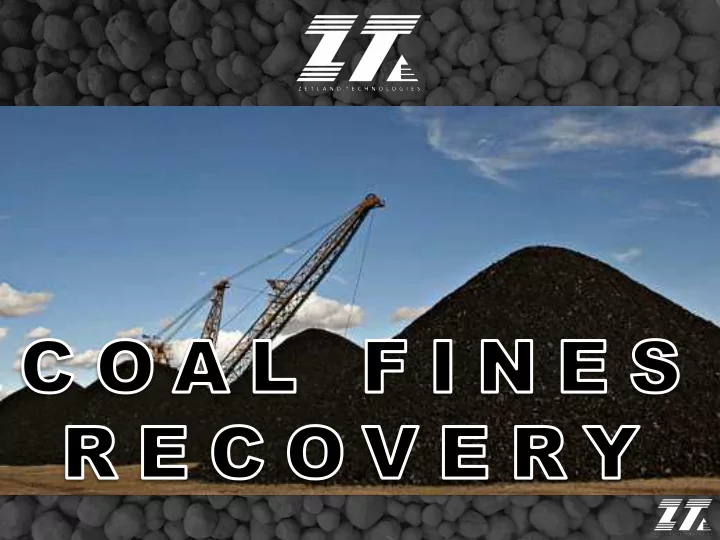

COAL MINING’S UNTAPPED RESOURCE Anywhere between 5% and 17`% of all coal mined typically ends up as coal fines. Over 850 million tonnes of discard is produced annually around the globe. 65 million tonnes accumulate within South Africa each year. The global stockpile is esFmated to be 20 billion tonnes and a Department of Mineral Resources survey indicates 1.9 billion tonnes lie dormant in South Africa.
WHERE DO COAL FINES END UP? Some of these discards can be beneficially used ‘as is’ for power generaFon or conversion to liquid fuels. Most are simply stored on site– in old mine shaPs, in slimes dams, or in stockpiles. All of this coal was mined, washed, dumped and stockpiled at a real cost and with a significant future liability to the mine.
ENVIRONMENTAL IMPACT Old discard dumps pose a serious and present threat to the environment, polluFng the atmosphere, rivers, ground water and the aestheFcs of the countryside through: § Acid mine drainage, § Spontaneous combusFon, § Fine airborne maTer poses potenFal health risks to exposed local communiFes and could contaminate surrounding ecosystems.
What has been done, and what is being done, to address these issues?
PELLETIZING PelleFzing coal fines was first done in the USA during WWII to maximize coal producFon. It has conFnued in various forms ever since but moisture content, the high cost of binders, and producing a waterproof product at a reasonable cost have limited its potenFal. Binderless coal pelleFzing produces a strong product, from a relaFvely dry material, but it is not waterproof.
BRIQUETTING Brique\ng as a method of upsizing coal fines gains favour when coal prices are at their peak. Controlling moisture in the coal is both a cost and a performance issue. Brique\ng tends to be an opFon with higher value coals, especially those used in metallurgy. There is a very high capital cost for the equipment.
AGGLOMERATION AgglomeraFon is a less precise method of upsizing. The product needs to be dry to be handled adequately. Binder costs tend to be high and their applicaFon less controllable. The capital cost for the equipment is lower but moisture content is criFcal. In conjuncFon with advanced granulaFon techniques, agglomeraFon has its place.
What has Zetland done differently and what commercially viable solutions can it offer now?
MOISTURE BEFORE, DURING & AFTER Zetland’s binder technology temporarily gels coal slimes as moist as 24% in such a way that it can be extruded effecFvely – much weTer than could normally be handled. Through the process of syneresis the water used to temporarily gel this slurry is rapidly expelled once it has been upsized making drying rapid. An auxiliary binder is added at the end of the process to completely waterproof the product.
CONSISTENCY Extrusion is the most proven technology in coal fines upsizing. JC Steele are global leaders in sFff extrusion and their equipment is in use in major mining countries around the world. The operaFon and maintenance costs are well defined. Whatever tonnage is required, a turnkey soluFon is available with world class service and support.
COSTS ARE IMPERATIVE Coal is at its lowest price in seven years. Recovering coal fines makes no commercial sense unless the cost is MORE aTracFve than mining virgin coal. Zetland’s binder costs, including waterproofing, are less than 70 rand per tonne. OperaFon and Maintenance costs range between 20 and 35 rand per tonne. The cost threshold has been overcome and recovery is now viable.
Zetland Technologies Limited 8 th Floor, On Hing Building 1 On Hing Terrace, Central, Hong Kong www.zetlandtechnologies.com eureka@zetlandtechnologies.com
Recommend
More recommend